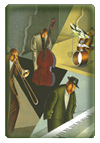| |
The Autobiography of an Ex-Colored Man.
Three Negro Classics. New York: Avon Books,
1965. pp.447-449. |

We at length secured places at a table in a corner of
the room and, as soon as we could attract the attention
of one of the busy waiters, ordered a round of drinks.
When I had somewhat collected my senses, I realized
that in a large back room into which the main room opened,
there was a young fellow singing a song, accompanied
on the piano by a short, thickset, dark man. After each
verse, he did some dance steps, which brought forth
great applause and a shower of small coins at his feet.
After the singer had responded to a rousing encore,
the stout man at the piano began to run his fingers
up and down the keyboard.
This he did in a manner in which indicated that he was
a master of a good deal of technique. Then he began
to play; and such playing! I stopped talking to listen.
It was music of a kind I had never heard before. It
was music that demanded physical response, patting of
the feet, drumming of the fingers, or nodding of the
head in time to with the beat.
The barbaric harmonies, the audacious resolutions, often
consisting of an abrupt jump form one key to another,
the intricate rhythms in which the accents fell in the
most unexpected places, but in which the beat was never
lost, produced a most curious effect. And, too, the
player-the dexterity of his left hand in making rapid
octave runs and jumps was little short of marvelous;
and with his right hand he frequently swept half the
keyboard with clean-cut chromatics which he fitted in
so nicely as never to fail to arouse in his listeners
a sort of pleasant surprise at the accomplishment of
the feat. This was rag-time music, then a novelty in
New York, and just growing to be a rage, which has not
yet subsided. It originated in the questionable resorts
about Memphis and St. Louis by Negro piano-players who
knew no more to the theory of music than they did of
the theory of the universe, but were guided by natural
musical instinct and talent. It made its way to Chicago,
where it was popular some time before it reached New
York.
These players often improvised crude and, at times,
vulgar words to fit the melodies. This was the beginning
of the ragtime song. Several of these improvisations
were taken down by the white man, the words slightly
altered, and published under the names of the arrangers.
They sprang into immediate popularity and earned small
fortunes, of which the Negro originators got only a
few dollars. But I have learned that since that time
a number of coloured men, of not only musical talent,
but training are writing out their own melodies and
words and reaping the reward of their work. I have learned
also that they have a large number of white imitators
and adulterators. * * * * * * I became so interested
in both the music and the player that I left the table
where I was sitting, and made my way through the hall
into the back room, where I could see as well as hear.
I talked to the piano-player between the musical numbers
and found out that he was just a natural musician, never
having taken a lesson in his life....I sat by, watching
and listening to this man until I as dragged away by
my friends. The place was now almost deserted; only
a few strangers hung on, and they were all the worse
for drink. My friends were well up in this class. We
passed into the street; the lamps were pale against
the sky; day was just breaking. We went home and got
into bed. I fell into a fitful sort of sleep, with ragtime
music ringing continually in my ears.
|